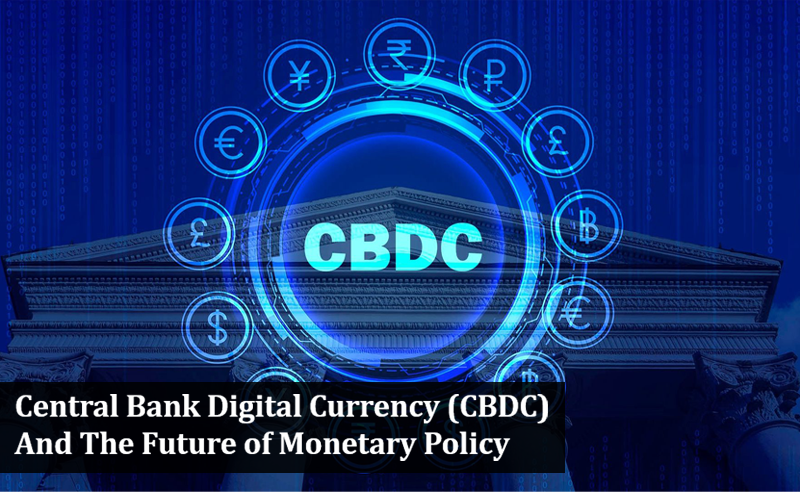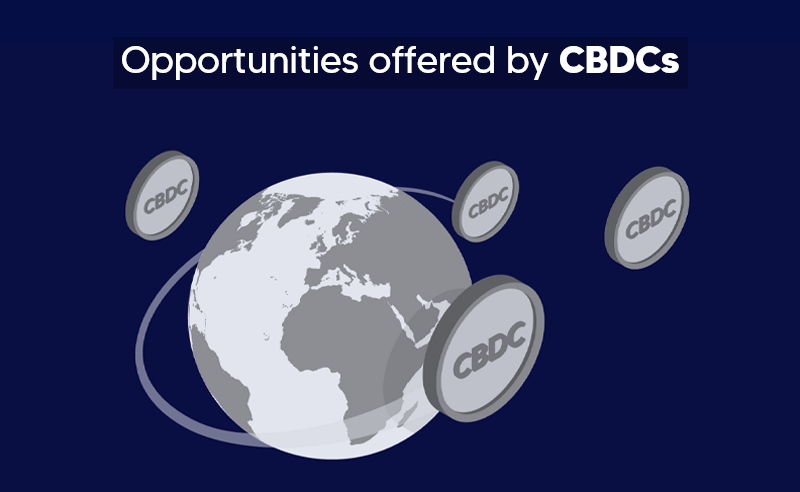Table of Contents
Not only electronic devices and high-speed digital networks are storming the financial space, but digital currency is also coming into picture for the banking and financial sector. Central banks like the People’s Bank of China, Bank of Canada, Bank of England, and many more are considering the possibilities to introduce sovereign digital currencies in their country. Some of the countries have accelerated the decision-making process while others are experimenting with technical specifications before the launch of Central Bank Digital Currency (CBDC). So, do you know about CBDC? CBDC is the digital currency that is meant to be fixed in nominal terms having universal accessibility with the validity of legal tender for both public and private transactions. In this article, we will learn about the Central Bank Digital Currency and the future of monetary policy.
What is Central Bank Digital Currency (CBDC)?
CBDC or Central Bank Digital Currency is a form of currency based on Blockchain technology but meant to be directly issued by central banks or institutions of the country for both supplementing paper currency and to give competition to cryptocurrencies like Bitcoin. CBDC has the potential to transform the banking sector by being the part of monetary policy, impacting the speed of transactions, better management of databases, and everything from reaching the unbanked population to seamless cross border transactions.
The concept of CBDC was first mentioned in news related to “Central Bank Digital Currency Bank of England” in 2015 when the Central Bank of England focussed on the need for digital currency. Let us try to find out some of the characteristics which make the CBDC different from both fiat currency and cryptocurrency.
- Centralized: Unlike the cryptocurrency, CBDC will be administered and regulated by the central authority or financial institutions.
- Digital form: Unlike the fiat currency, which consists of physical notes and coins minted under a highly securitized environment, CBDC are digitally verified transactions on the Blockchain network.
- Non backed: As the fiat currency of any country becomes the victim of the policies of the US (being backed by Dollars), CBDC is not dependent on any country and thus non-inflationary as the unit of account for economic transactions.
- Costless: CBDC is based on a Blockchain network, thereby the transaction cost and time reduced to the minimum limits.
Central Bank Digital Currency And The Future Of Monetary Policy | Benefits of CBDC

As per the Central Bank Digital Currency IMF report, the introduction of CBDC has the potential to secure the settlement of cross-border financial transactions in less time and cost. Central authorities and institutions are exploring the opportunities to implement CBDCs in their systems or potential of Central Bank Digital Currency and the future of monetary policy due to the following reasons :
- Costless medium of exchange: Practically, while transacting the CBDC, transaction costs are minimal, making it nearly a costless medium of exchange. CBDC can be beneficial specifically to small businesses that have to bear high cash handling and interchanging costs while taking the payments via credit and debit cards.
- Speedy currency: Many central banks across the world consider that CBDC can pass the processes of printing or minting along with transportation to the proper infrastructure like banks, ATMs, and many more. Also, head of Central Bank of Bahamas, John Rolle advocated that rollout of CBDC not only speeds up the transaction but could facilitate in financial recovery after hurricanes by accelerating the process of real-time payments and deposits.
- Safer financial system: CBDC could allow the individuals private sector companies and also Non-Banking Financial Institutions (NBFCs) to have their settlements in central bank money rather than deposits. This would help in reducing the accumulation of liquidity and credit risk in payment systems. Also, people could explore the chances to alternative to bank deposits, which is more risk-free reducing the needs of government guarantees on deposits. Thus, the source of the financial system’s moral hazard could be eliminated.
- Better monetary policy: Presently, central institutions generally do not pass the ease or benefits implied on them by higher authorities like lower policy rates. With the introduction of CBDC, changes in policy rates or any other benefits can be directly enforced to the monetary transmission channel reaching to the households and enterprises, thereby strengthening the channel.
- Compensating alternative finances: When non-banking institutions like peer-to-peer lenders are involved in the majority of lending processes, consequences are faced while money creation and distribution. Many times peer-to-peer lending is preferred by the people of low incomes because when banks offer loans, it builds new deposits for the borrower. On the contrary, moneylenders directly transfer the pre-existing deposits from their savings account to the borrower account.CBDC can help in shifting the lending institutions by easing the process with maximum accessibility and least of procedures, as mentioned in a report related to CBDC Bank of England.
- Financial Inclusion: In most of the developing countries, the majority of the population left unbanked either due to improper infrastructure, lack of documents, or due to little awareness of the banking system. The introduction of CBDC in the system can facilitate the inclusion of left out people with minimal documents and relatively with no physical infrastructure, which can be termed as CBDC financial inclusion.
- Macroeconomic stability: Central banks all across the world aim for positive inflation rates of 2% or more for maintaining lower bound to respond to adverse shocks. Once the CBDC is introduced, the interest rate adjustment might be facilitated by interest-bearing design of CBDCs which will aid in eliminating the need for maintaining the inflation buffer or the deployment of monetary policy tools like quantitative easing and credit subsidies.
- Discourage illicit activities: Challenges related to counterfeiting, money laundering, tax evasion, and other illegal activities are associated with fiat currency especially, large denomination bills or notes. Blockchain technology-based CBDC can reduce the illicit activities as it offers a highly secured tamper-proof transparent network with easy tracking of transactions.
Projects Related To CBDCs

The implication of CBDCs by any country does not follow the easy procedure due to the number of political, digital, and economical challenges. But some of the countries outweigh the risks with opportunities, favoring the strong central bank system with less regulation and facilitating the citizens of the country as per the latest CBDC news.
- Project Ubin, Monetary Authority of Singapore: Introduced Blockchain-enabled CBDC for strengthening complex workflows of payment and decentralized liquidity mechanism.
- Project Jasper, Bank of Canada, and Canadain Stock Exchange: Aimed at maintaining the 24/7 accessibility of payment systems with digital infrastructure of Blockchain-based CBDC.
- Project Inthanon, Bank of Thailand, and Hong Kong Monetary Authority: Initiated the cross-border payment system with the launching of CBDC.
- Open Banking, United Kingdom: Initiative promoting the deployment of CBDC for exploring the synergies between finance, data mining, and management.
Summing Up
Blockchain technology-based Central Bank digital Currency assures the better architecture for a secure payment system with no intermediary point of failure while maintaining the integrity of the banking system of the country. CBDCs under the robust governance frameworks can be the new future for the medium of exchange. Central Bank Digital Currency and the future of monetary policy not only hold the seamless connectivity between common people, companies, and financial institutions but also includes the monetary sovereignty and macroeconomic stability of the system.

